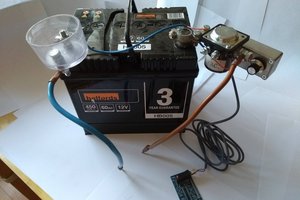I recently built a couple of battery packs out of recovered laptop 18650 LiPos.
While this has no doubt been done a thousand times before, I thought it worth a quick write up here. The hard work is being done by one of these modules, take care when looking for these to ensure you get the protected version.
The objective is to build a safe 3.6 V approx. supply out of unprotected 18650 cells. In theory we can parallel up as many as we like, but in practice probably 4 or 6 cells would be about as far as we can push the little charger board we are going to use, without modification. More cells would give us a longer running time, but would also proportionally increase the charge time.
I'm using my packs to power a Canon P&S camera running CHDK, but you can obviously use the method to power anything that will operate on 3.6V. Long timelapses and long duration motion detection are two of my goals. So far I have managed to power the camera for more than 24 hours at a stretch.
We also need to be careful with recovered cells, often one or two of them may be unwise to re-use, if they have been allowed to discharge below the safe limit. Discard anything which reads less than 1.5V, it is almost certainly not worth the risk of recharging, cells left at or below this threshold for prolonged periods can fail dramatically when you attempt to recharge them.
Of the two dozen or so cells I have recovered recently, only one was unserviceable. It had failed open circuit, and this failure may well have been the reason the entire pack no longer took a charge. It is probable that single cell failure is one of the conditions that the inbuilt charge protection controller in laptop packs can sense. It is therefore entirely plausible that the charge controller in the pack deemed the pack unsafe to recharge as a result of this condition.
You could of course use new 18650 cells, as they are available reasonably cheaply from all of the usual sources (often with wildly exaggerated capacities, and potentially of dubious quality). I would suggest however that recovered cells, make for a more interesting build, and are usually high quality cells.
Recovering them involves quite a bit of genuine "hackery", while extracting them from the failed laptop battery. Watch your fingers while you attempt this, the tabs on the cells (which you need to carefully detach and remove with a pair of pliers) are razor sharp.
There are several youtube videos showing what is involved, so I wont go over that here. Use suitable gloves to protect you from the sharp edges, and take care not to short out anything. Work in a location where you will not be too worried about throwing the hot, hissing firecracher that is an errant lipo out of harms way. Take care with sharp knifes and conductive screwdrivers, a stabbed or shorted LiPo is a dangerous one.
Everything described here, you do it *entirely* at your own risk. Don't forget your safety neck tie .
Laptop battery packs are "intelligent" in the sense that they contain a charge monitoring circuit, which will kill the battery (usually permanently) if it detects any problem. Often a single cell failure is all it takes for the charge monitoring circuit to deem the battery beyond its serviceable life, and under these circumstances, all of the remaining cells are usually perfectly usable (assuming they have not been allowed to discharge below 1.5 V).
Unprotected LiPo cells are also slightly more dangerous than some other battery technologies, in that if we short them out, things can quickly get out of hand. Melted wires, smoke, flames, potentially even an explosion can result, so care must be taken when constructing this build. Having said all that, lead acid, Nicad, NiMh .. in fact pretty much any battery technology can set things on fire, so LiPo's are not unique in this resepect.
If you would like to learn a bit more about cell and battery technology, one of the best battery related resources on the web can be found at batteryuniversity.com...
Read more » andyhull
andyhull
 Simon Merrett
Simon Merrett
 Rory
Rory
 Drew Pilcher
Drew Pilcher
 Bud Bennett
Bud Bennett